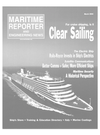
Contract for New Product Tanker Design
A contract covering the design of a 4,200dwt oil product tanker has been won by NVC -Design. It represents the first ship to be built to a concept developed by Rolls-Royce, a design which combines a tailormade hull design with a diesel mechanical propulsion system based on twin Ulstein Aquamaster Azipull azimuth thrusters with pulling propellers.
This design has been given the type number NVC 604 PT.
The vessel has been contracted by Norway's Bergen Tankers AS. and it will be built by RMK Marine Shipyard in Turkey, scheduled for delivery in September 2005. Rolls-Royce is to deliver the design and the Azipull thrusters.
The concept is intended to provide a number of advantages, perhaps most importantly an increase in cargo space compared to a conventional single screw product tanker, as the azimuth thruster system allows the engine room bulkhead to be moved further aft.
Depending on the size of vessel, the increase in cargo volume is 5-19c.
By using two independent propulsion lines comprising thruster. shaft generator and main engine, a high level of redundancy is achieved. It also means that maintenance work can be carried out on one engine when the vessel is working cargo in port, since the other unit, assisted by the tunnel bow thruster. is immediately available to take the vessel to safety should an emergency arise at the terminal. Propulsion system redundancy also increases the level of safety in coastal navigation.
In developing the hull form, Rolls-Royce had to ensure that the ship would have good course keeping ability. Hulls with length to beam ratios desirable for low first cost and high earning capacity in the past tended to have poor course stability when propelled by azimuth thrusters, needing large steering corrections resulting in heavier fuel consumption.
Choosing the Azipull solution for propulsion is designed to help greatly, as they, with their hydrodynamically optimized underwater units, provide substantial rudder area. Even so, a major program of computational design and model testing was undertaken to ensure that the result would be a tanker with course stability well in excess of the IMO zig-zag test requirements.
The double hull vessel incorporates a bulbous bow, plus a short skeg for docking purposes. Azipull propulsors are positioned below headboxes and allow the aft end of the hull to be optimized for minimum resistance and simplified hull construction.
An attraction is that in port one engine can be shut down. The other is declutched from its thruster and drives its generator supplying power for the hydraulic deepwell cargo pump powerpacks and the vessel's hotel load.
The 4,200-dwt Rolls-Royce oil product tanker design on order for Bergen Tankers has a cargo hold volume of 5.200 cu. m. split between 10 tanks. These lie within the double hull which has an overall length of fractionally under 90 m and a moulded breadth of 16.5 m; the summer draft is 6 m. Cargo heating is by stainless steel coils through which thermal oil is circulated. Each tank has its own cargo pump and the total discharge rate is 1.200 cu. m./hr.
Each main engine develops about 1,400 kW at 900 rpm, coupled to a 1,000 kW generator and an AZP85 Azipull thruster. Allowing for 15 percent sea margin and hotel load on the shaft generator the service speed at 90% MCR will be 13.3 knots, with a corresponding fuel consumption of about 8 tons/24 hrs. A 500kW tunnel bow thruster is electrically driven and the shaft generators are backed up by two 350kW gensets and a small harbor/emergency set.
Circle 69 on Reader Service Card
Other stories from March 2004 issue
Content
- Bollinger Delivers Tidewater Supply Boat Jonathan Rozier page: 8
- World's Largest Dry Transport Vessel Delivered page: 10
- Port security: A Historical Perspective page: 12
- Delayed Enforcement of Change to "Shipper" Element page: 16
- MTSA: Another Key Layer of Port Security page: 17
- When Security is Made Simple page: 20
- Business Milestone for Vietnam page: 24
- "Made in Germany1 — a New High page: 24
- Miracle on Ice page: 26
- New President & CEO at Kvaerner Masa-Yards page: 28
- He's No Regular Joe page: 30
- Cruise Passenger Travel Grows 8 Percent; New York and Galveston Post Big Gains page: 32
- HAL's Vista Sails with ROCHEM Technology page: 33
- Royal Caribbean Takes Mariner of the Seas page: 34
- NorseMerchant Ferries Plans Service Upgrade page: 37
- Grimaldi Continues Fast Track Expansion page: 38
- Costa Places $450m Order With Fincantieri page: 40
- Losing ontact... Not an Option page: 44
- Ship Security Alert Systems (SSAS) page: 50
- GALILEO Lifts Off page: 52
- Icebreaker Uses Satellite to Break Through Communications Barriers page: 55
- Cellular Fixed Wireless Helps Deliver Mercy page: 57
- Homing in on Ships' Electrics page: 58
- Shipconstructor Chosen as Standard page: 61
- Contract for New Product Tanker Design page: 62
- BollFilter: 50 Years of Success and Counting page: 65
- The Corrosion Control Challenge page: 66
- Nippon Paint Restructures page: 69
- Metal Fusion Helps Stop Corrosion page: 69
- Maritime Security Professional Training page: 72
- Training the Trainer to Keep Knowledge Afloat page: 74

